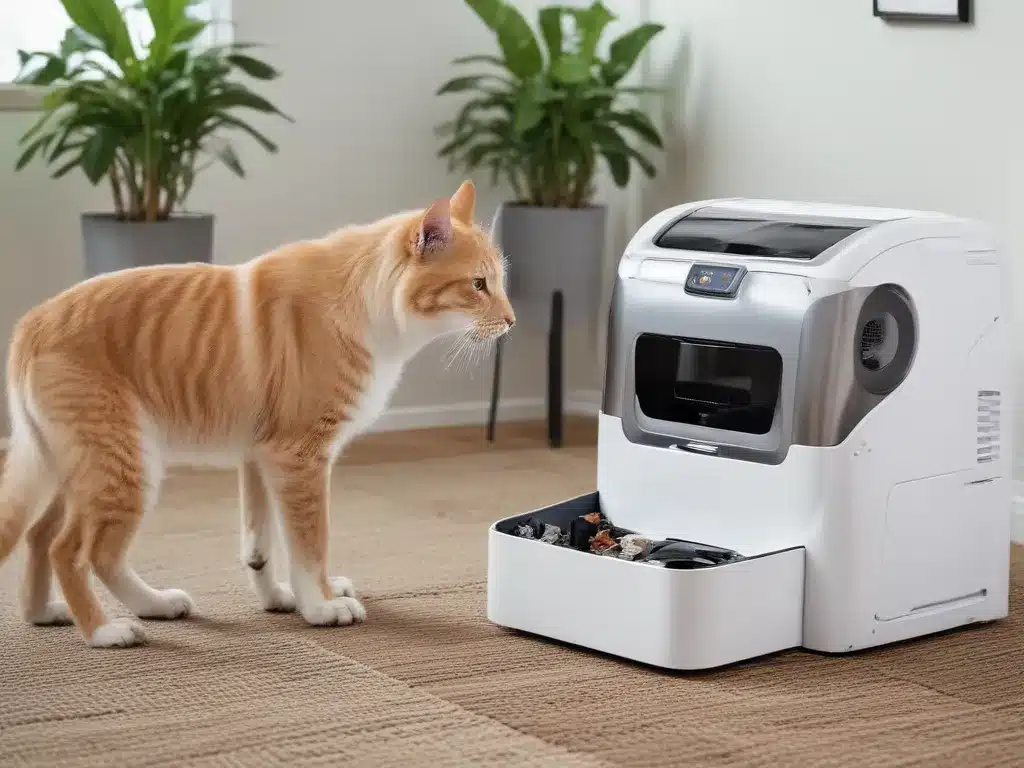Introduction
As a pet owner, I understand the challenges of maintaining a clean and odor-free living environment. Traditional litter boxes require frequent scooping and disposal, which can be a tedious and unpleasant task. However, with the advent of robot litter boxes, keeping your home fresh and hygienic has become more convenient than ever before. In this article, I will explore the benefits, features, and considerations of these innovative devices, helping you stay ahead of messes and providing your furry friends with a clean and comfortable environment.
What are Robot Litter Boxes?
Robot litter boxes – are automated self-cleaning litter boxes – that use advanced sensors and mechanisms – to detect and remove waste from the litter. They typically consist of a base unit – that houses the litter tray, and a waste compartment – where the clumps of waste are deposited after being raked or sifted. Some models even feature automatic litter refilling – and odor control systems – to ensure a fresh and hygienic environment.
Benefits of Using a Robot Litter Box
1. Convenience and Time-Saving
One of the most significant benefits of robot litter boxes – is the convenience they provide. With traditional litter boxes, scooping and disposing of waste – is a daily chore that can be time-consuming and unpleasant. Robot litter boxes – automate this process, saving you valuable time – and effort.
2. Improved Hygiene
Robot litter boxes – help maintain a cleaner and more hygienic environment – by removing waste promptly. This not only reduces odors – but also minimizes the risk of bacterial growth – and the spread of harmful pathogens.
3. Odor Control
Many robot litter boxes – feature advanced odor control systems – that use carbon filters, ionizers, or other technologies – to neutralize unpleasant smells. This ensures a fresher and more pleasant living environment – for both you and your pet.
4. Monitoring and Tracking
Some robot litter boxes – come equipped with monitoring and tracking features – that allow you to monitor your pet’s litter box usage and habits. This can be particularly useful – for detecting potential health issues or behavioral changes.
Choosing the Right Robot Litter Box
When selecting a robot litter box, consider the following factors:
-
Size and Capacity: Choose a model that is appropriate for the size and number of pets you have. Larger cats or multiple cats may require a larger litter box with a higher capacity.
-
Noise Level: Some robot litter boxes can be noisy during operation, which may disturb you or your pets. Look for models with quiet operation or consider placing the litter box in a less-trafficked area.
-
Ease of Cleaning: While robot litter boxes automate the scooping process, you will still need to periodically clean and maintain the unit. Look for models with easy access and removable components for hassle-free cleaning.
-
Connectivity and Smart Features: Some robot litter boxes offer smart features like Wi-Fi connectivity, mobile apps, and notifications, allowing you to monitor and control the device remotely.
-
Safety Features: If you have young children or curious pets, consider models with safety features like child locks or automatic shutoff mechanisms to prevent accidental injuries or spills.
Setting Up and Maintaining Your Robot Litter Box
To ensure your robot litter box functions optimally, follow these steps:
-
Choose the Right Location: Place the litter box in a quiet, easily accessible area with plenty of ventilation. Avoid areas with high foot traffic or near heating/cooling vents.
-
Proper Litter Selection: Use clumping litter specifically designed for robot litter boxes. Avoid litters that are too fine or too coarse, as they may interfere with the raking or sifting mechanism.
-
Regular Maintenance: Follow the manufacturer’s instructions for cleaning and maintaining the litter box. This may include emptying the waste compartment, replacing filters, and checking for any clogs or malfunctions.
-
Transitioning Your Pet: Introduce your pet to the robot litter box gradually. Place the new litter box near the old one and gradually move it to its permanent location once your pet becomes accustomed to using it.
Real-Life Case Studies
To better understand the benefits of robot litter boxes, let’s explore some real-life case studies:
Case Study 1: The Busy Professional
Sarah, a busy professional with a demanding job, often found it challenging to keep up with the daily scooping and cleaning of her cat’s litter box. After investing in a robot litter box, she noticed a significant improvement in her home’s cleanliness and odor control. The automated scooping and odor control features allowed her to focus on her work without worrying about litter box maintenance.
Case Study 2: The Multi-Pet Household
The Johnson family had three cats and struggled to keep their home free from litter box odors and messes. After trying various litter box solutions, they decided to invest in a high-capacity robot litter box. The large waste compartment and advanced odor control system made a remarkable difference, allowing them to enjoy a fresh and clean living environment without the constant need for scooping and cleaning.
Conclusion
Robot litter boxes offer a convenient and hygienic solution for pet owners seeking to maintain a clean and odor-free living environment. With their automated scooping, odor control, and monitoring features, these innovative devices save time and effort while providing your furry friends with a comfortable and clean space. By considering your specific needs and following proper setup and maintenance guidelines, you can stay ahead of messes and enjoy a hassle-free pet ownership experience.







